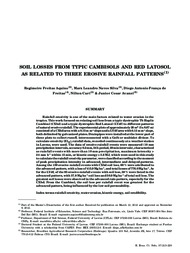Soil losses from typic cambisols and red latosol as related to three erosive rainfall patterns.
Soil losses from typic cambisols and red latosol as related to three erosive rainfall patterns.
Author(s): AQUINO, R. F.; SILVA, M. L. N.; FREITAS, D. A. F. de; CURI, N.; AVANZI, J. C.
Summary: Rainfall erosivity is one of the main factors related to water erosion in the tropics. This work focused on relating soil loss from a typic dystrophic Tb Haplic Cambisol (CXbd) and a typic dystrophic Red Latosol (LVdf) to different patterns of natural erosive rainfall. The experimental plots of approximately 26 m2 (3 x 8.67 m) consisted of a CXbd area with a 0.15 m m-1 slope and a LVdf area with 0.12 m m-1 slope, both delimited by galvanized plates. Drainpipes were installed at the lower part of these plots to collect runoff, interconnected with a Geib or multislot divisor. To calculate erosivity (EI30), rainfall data, recorded continuously at a weather station in Lavras, were used. The data of erosive rainfall events were measured (10 mm precipitation intervals, accuracy 0.2 mm, 24 h period, 20 min intervals), characterized as rainfall events with more than 10 mm precipitation, maximum intensity > 24 mm h-1 within 15 min, or kinetic energy > 3.6 MJ, which were used in this study to calculate the rainfall erosivity parameter, were classified according to the moment of peak precipitation intensity in advanced, intermediate and delayed patterns. Among the 139 erosive rainfall events with CXbd soil loss, 60 % were attributed to the advanced pattern, with a loss of 415.9 Mg ha-1, and total losses of 776.0 Mg ha-1. As for the LVdf, of the 93 erosive rainfall events with soil loss, 58 % were listed in the advanced pattern, with 37.8 Mg ha-1 soil loss and 50.9 Mg ha-1 of total soil loss. The greatest soil losses were observed in the advanced rain pattern, especially for the CXbd. From the Cambisol, the soil loss per rainfall event was greatest for the advanced pattern, being influenced by the low soil permeability
Publication year: 2013
Types of publication: Journal article
Observation
Some of Embrapa's publications are published as ePub files. To read them, use or download one of the following free software options to your computer or mobile device. Android: Google Play Books; IOS: iBooks; Windows and Linux: Calibre.
Access other publications
Access the Agricultural Research Database (BDPA) to consult Embrapa's full library collection and records.
Visit Embrapa Bookstore to purchase books and other publications sold by Embrapa.

